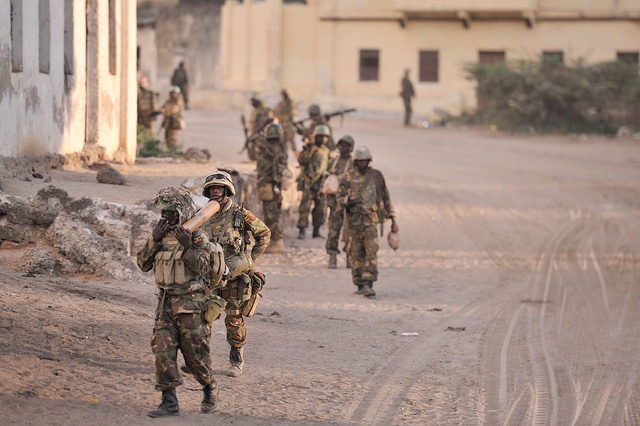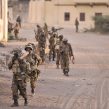
Al-Shabaab to Face Different Direction after Appointment of New Leader
Publication: Terrorism Monitor Volume: 12 Issue: 21
By:

In recent months, Somalia’s main Islamist militant group, Harakat al-Shabaab al-Mujahideen, better known as al-Shabaab, has suffered serious setbacks in its conflict with African Union Mission in Somalia (AMISOM) troops. Since al-Shabaab’s establishment in 2006, the organization had successfully entrenched its authority in central and southern Somalia, where it has implemented a hardline form of Shari’a or Islamic law. However, on October 6, its grip on the region appeared to falter after the militants lost the southern coastal town of Barawe to AMISOM forces in Operation Indian Ocean (Sabahi Online, October 6). The coastal town, one of the group’s most significant strongholds since it lost control of the capital Mogadishu in 2011 and the lucrative port of Kismayo in 2012, had served as an economic hub for the movement, especially for the illegal export of charcoal, as a transit point for arms imports, and as a logistical center. Situated about 125 miles southwest of Mogadishu, Barawe was also the last Somali seaport under al-Shabaab’s control.
Nearly a month before, however, the militant group had suffered another major blow when a U.S. airstrike killed its leader and most prominent ideological figure, Ahmad Abdi Godane (a.k.a. Mukhtar Abu Zubayr) on September 1. Godane, who was 37-years-old, had overseen the growth of al-Shabaab from a local Somali jihadist group to a regional and international one. Rejecting Somali government overtures for a ceasefire, Godane, in 2009, had also notably declared allegiance to al-Qaeda. Godane’s predecessor, Shaykh Adan Hashi Ayrow, was killed in a similar airstrike in 2008 (Somalia Report, September 2).
On September 6, al-Shabaab named a little known cleric, Shaykh Ahmad Umar (a.k.a. Abu Ubaidah) as its new leader (Daily Nation [Nairobi], September 6). Umar is believed to be in his early 40s and is known to be a hardliner within the movement (WardheerNews, September 10). He was born in the Kalafe area of the Ogaden region before moving to southern Somalia, where he helped establish Islamic schools. He also served as al-Shabaab’s governor for the Bay and Bakool regions (Somali Current, September 6).
Umar’s appointment will play a key role in shaping the direction of the militant group. It could be argued that al-Shabaab’s loss of its key leader, its main sources of income and significant amounts of territory signals the beginning of the end of the movement. However, a closer look at the militants’ recent actions after the death of Godane indicates that al-Shabaab remains a very lethal and capable organization. The final defeat of the group will therefore likely remain elusive, despite the surge against it by AMISOM, and military actions, especially by foreign armies, are unlikely to bring this about singlehandedly.
Al-Shabaab’s manpower illustrates the group’s continued survival and its enduring military potency. Al-Shabaab’s intelligence wing, Amniyat, and its military wing, known as Jabhad, have an estimated force strength of 5,000 fighters (Panapress, January 12). Some security organizations estimate that it has about 1,000-4,000 fighters of which at least 200-400 are believed to be foreigners. By comparison, at its inception eight years ago, the group boasted of thousands of fighters. Many of these fighters have been killed, while others have defected, but the group nonetheless clearly continues to command a considerable force.
In addition, al-Shabaab has displayed a remarkable flexibility, adapting militarily and politically to a wide range of events, especially when under pressure. Indeed, al-Shabaab is itself a consequence of such flexibility and adaptation, having emerged eight years ago as an offshoot of the Union of Islamic Court (UIC) after the courts’ defeat by an alliance led by the Transitional Federal Government (TFG) forces and Ethiopian troops.
Such adaptability has been evident in al-Shabaab’s ongoing conflict with AMISOM troops. In the last few years, the militant group has largely avoided head-on contact with AMISOM’s 22,000 strong forces, withdrawing its fighters and weapons from advancing forces. Its fighters, instead of directly confronting AMISOM, typically melt away, splitting into small groups and then returning to launch often devastating guerrilla attacks. The groups carry out suicide bombings, small arms attacks and detonate remote controlled bombing, which are usually planted on road sides.
Godane had widely used such tactics with some great successes within Somalia. Although Umar, since his appointment in September, has not announced publicly how he plans to lead the group and has not issued any address to al-Shabaab’s fighters, operationally may have little choice but to continue al-Shabaab’s strategy of guerrilla warfare (Sabahi Online, October 22).
The group has escalated its assassinations of government officials and opposition members. As well as striking in Mogadishu, al-Shabaab has also cut supply lines to towns liberated by AMISOM, in addition to stopping aid from reaching these towns, forcing to residents to move elsewhere in search of food. This has undermined the government’s promise that the removal of al-Shabaab from such areas would lead to a better life (Standard Media, October 10).
Al-Shabaab has also continued to carry out bomb attacks in urban areas. On October 15, five people were killed and several wounded in a car bomb explosion linked to the militants in a busy street in Mogadishu (Hiiran Online, October 16). According to news reports, several shells had been fired by the militants before the blast. Four days earlier, another car bomb had exploded at the entrance to a restaurant in the city killing seven people and injuring several others. Al-Shabaab also took responsibility for an attack on a hotel located near the Somali parliament, which targeted government officials and prominent Somali leaders. In addition, on September 8, days after the killing of Godane, the militants had carried a twin attack on AMISOM forces in Mogadishu, killing at least 12 people (Xinhua, September 8).
Godane had tried to pursue a wider jihadist agenda by carrying out attacks across the region, shifting the battleground from “wild jungle” to the “concrete” or “urban jungle.” As a result, suicide attacks occurred in towns and cities in Kenya, Djibouti and Uganda. Most notably, on September 21, 2013, al-Shabaab attacked Westgate, an upscale shopping mall in Nairobi’s Westlands area, killing 67 people. Godane took responsibility for the assault and also threatened more attacks. In July 2010, the group had carried out suicide bombing against crowds watching the screening of a FIFA World Cup match in Kampala, Uganda (Guardian, July 12, 2010). Smaller attacks targeting churches, public places and public transport have also occurred in Kenya and attacks on foreigners have occurred in Djibouti.
The group under Umar appears to be following a similar regional agenda; on October 18, Kenyan soldiers killed five al-Shabaab militants and recovered 100 kilograms of TNT explosives and six suicide bomb vests when the militants attempted to cross into Kenya by car using Ethiopia’s Dolo border crossing point near Moyale town (Daily Nation [Nairobi], October 19).
Similarly, from an ideological and political perspective, Umar will probably not implement a major shift in al-Shabaab’s relationships with the Somali government or with al-Qaeda and a large element of continuity should be. [1] At the same time, however, some significant changes can be expected. While Godane’s high handedness resulted in deep divisions within al-Shabaab and even defections, there are growing reports that Umar is reaching out to formerly dissenting leaders with a view to bringing them back to the fold, again underlining the enduring flexibility of the movement (Somalia Newsroom, September 22).
In conclusion, while Umar has remained silent about his plans for the future direction of al-Shabaab, it would be wrong to assume that the group’s recent setbacks and the death of its long-standing leader mean that the defeat of al-Shabaab is imminent. Instead, although the group will likely continue to lose territory to AMISOM, its fighters are likely to continue to melt away in the face of military offensives, before attacking again elsewhere. At the same time, clan rivalry will remain the peg on which the Somali conflict hangs and the tactics and direction that al-Shabaab will take in the post-Godane period will depend largely on Umar’s management of clan politics. In the past, al-Shabaab has depended extensively on the support of clans to win the control of areas of central and southern Somalia and the clans are likely to prove equally essential to it in the future.
Sunguta West is a journalist based in Nairobi, Kenya. He writes about politics, religion, security and environment, among other issues.
Note
1. “What changes for al-Shabaab after the death of Godane?,” Institute for Security Studies, October 8, 2014, https://www.issafrica.org/iss-today/what-changes-for-al-shabaab-after-the-death-of-godane.





